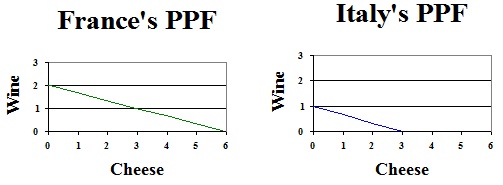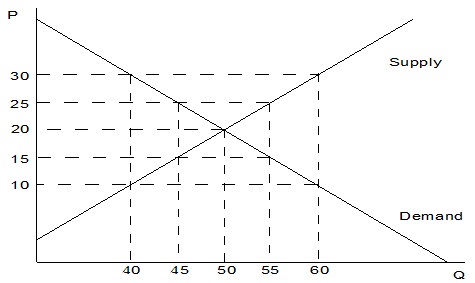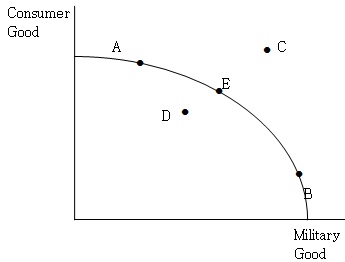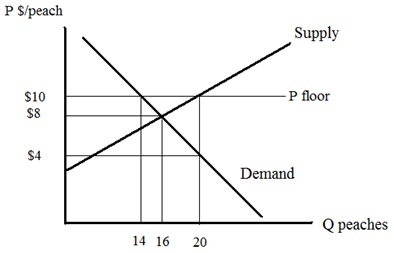BINARY CHOICE SECTION
Fill in the blanks for the next 3 questions:
Problem 1. ______ is a study of firms, markets, and pricing decisions.
a. Microeconomics
b. Macroeconomics
Problem 2. Economists use economic models for _____________.
a. Normative economics
b. Both normative and positive economics
Problem 3. The statement, “the major problem now is that the rich do not pay enough taxes,” is _______.
a. Normative
b. Positive
Use the following information to answer the next 3 questions:
Consider the market for a PlayStation 3 (a video game console). Assume we are starting with an upward sloping supply curve and a downward sloping demand curve.
Problem 4. Suppose a new game that everyone wants to play, Madden NFL 2009, will be available and can only be played on PlayStation 3. This new game has a new Online League feature that allows you and your friends to form your own league and play with your own drafted players. Holding everything else constant in the market for PlayStation 3, what will happen to the equilibrium price and quantity in this market?
a. Equilibrium price increases and equilibrium quantity increases.
b. Equilibrium price decreases and equilibrium quantity increases.
Problem 5. Suppose the Xbox 360 and the PlayStation 3 are substitutes for one another. Assume the market for the Xbox360 and the market for the PlayStation 3 are both initially in equilibrium. The price of the Xbox 360 significantly decreases. Holding everything else constant, what will happen to the price and equilibrium quantity of PlayStation 3?
a. The equilibrium price increases and the equilibrium quantity may increase, decrease, or remain the same.
b. The equilibrium price decreases and the equilibrium quantity decreases.
Problem 6. Experts determine that the PlayStation 3 results in obesity and carpal tunnel syndrome if played for long periods of time. At the same time, the price of silicon chips (an input used to make PlayStation 3) increases. What will happen to the price of PlayStation 3? Relative to the initial equilibrium price and quantity in this market,
a. The new equilibrium price may increase, decrease or remain the same and the equilibrium quantity decreases.
b. The equilibrium price decreases and the equilibrium quantity decreases.
Problem 7. If the government wants to limit the quantity of a product traded, it can always achieve that goal by enforcing an excise tax or price ceiling.
a. True
b. False
Use the following diagram to answer the next 3 questions:

Problem 8. Italy has the absolute advantage in the production of both Wine and Cheese.
a. True
b. False
Problem 9. Both France and Italy can benefit from specialization and trade.
a. True
b. False
Problem 10. Suppose a technology increase allows Italy to produce more Wine than it could initially. With this change in technology, which country will have the comparative advantage in Wine production?
a. France
b. Italy
Problem 11. Consider a PPF drawn for a country showing the maximum amount of two goods a country can produce from a given amount of resources, technology and time. This PPF is bowed out from the origin because
a. Some of the resources in this economy are more suited to the production of one of the goods than the production of the other good.
b. Gains can always be made when two goods are produced instead of one good.
Problem 12. Producer Surplus increases when the government imposes an effective price ceiling.
a. True
b. False
MULTIPLE CHOICE SECTION
Use the following information to answer the next 5 questions:
The graph below displays the demand and supply of red T-Shirts in Wisconsin.

Problem 13. What is the price and quantity that guarantees that the sum of consumer surplus and producer surplus are maximized?
a. $25 and 55 T-shirts
b. $20 and 50 T-shirts.
c. $15 and 55 T-shirts.
d. $15 and 45 T-shirts.
Problem 14. Suppose the government imposes on producers an excise tax of $20 per T-shirt. What will be the new market equilibrium price and quantity?
a. $30 and 40 T-shirts
b. $25 and 45 T-shirts.
c. $15 and 45 T-shirts.
d. $25 and 55 T-shirts.
Problem 15. Suppose the government imposes the excise tax of $20 per T-shirt. What is the decrease in Consumer Surplus due to the imposition of this tax?
a. $237.5
b. $450
c. $500
d. $550
Problem 16. Suppose the government imposes the excise tax of $10 per T-shirt instead. What is the Deadweight Loss due to the imposition of this excise tax?
a. $12.5
b. $25
c. $50
d. $100
Problem 17. Assume there is no excise tax in the market for red T-shirts. Suppose the government wants to promote the sale of red T-shirts. The government decides it wants to increase the sale of T-shirts to a total of 60 T-shirts. What will the subsidy per T-shirt need to be in order to achieve this goal?
a. $5
b. $10
c. $15
d. $20
Use the following information to answer the next 4 questions:
There are two lines. The equation for line A is y=3x-6. The equation for line B is y=2x-2. Assume that y is measured on the vertical axis and x is measured on the horizontal axis.
Problem 18. What is the y-intercept of line A?
a. -6
b. 2
c. -2
d. 6
Problem 19. What is the x-intercept of line B?
a. -2
b. 1
c. 2
d. -1
Problem 20. What is the intersection of line A and line B?
a. (x=4,y=6)
b. (x=1,y=-3)
c. (x=1,y=-1)
d. (x=4,y=2)
Problem 21. What is the equation for the line with the same slope as line B, but having an x-intercept that is 1 unit larger?
a. y=2x-4
b. y=-2x-4
c. y=2x-3
d. y=2x-1
Use the following diagram to answer the next questions:
The following figure shows the PPF for an economy that produces only consumer goods and military goods. Assume that points A, E, and B all lie on the PPF for this economy.

Problem 22. Which of the following statements is false?
a. Points A and B are feasible and efficient.
b. Point E is always more preferred than point A or B.
c. Point C is not feasible.
d. Point D is feasible, but inefficient.
Problem 23. Several store managers are discussing their sales volume. Which of the following quotations refers to a movement along the demand curve?
a. “We decided to cut our prices, and the increase in our sales has been remarkable.”
b. “Since our competitors raised their prices our sales have doubled.”
c. “People are becoming wealthier and they are buying much more compared to last year.”
d. “This merchandise is becoming out of fashion and its sales are plummeting.”
Problem 24. If the price of a product increases, we would expect
a. the demand curve for that product to decrease.
b. the quantity supplied of that product to increase.
c. the supply curve of that product to increase.
d. the quantity demanded of that product to increase.
Use the following information to answer the next question:
Fruitgarden produces only two fruits, coconuts and pineapples. The following table gives the different feasible production combinations for Fruitgarden. Assume that the Production Possibility Frontier is linear between combinations A to B, B to C, C to D, etc.
Combination Coconuts (per week) Pineapples (per week)
A 200 0
B 150 80
C 110 120
D 60 160
E 0 200
Problem 25. Suppose Fruitgarden is currently producing at point C. What is the opportunity cost of producing 1 more unit of Pineapples?
a. 0.5 unit of Coconuts
b. 1 unit of Coconuts
c. 1.25 units of Coconuts
d. 1.5 units of Coconuts
Problem 26. Which of the following goods can be considered complements?
a. notebooks and pencils
b. milk and lemonade
c. hard candy and apples
d. coffee and tea
Use the following information to answer the next 4 questions:
In the USA, the demand for apples is Qd=100-P. The supply of apples in the USA is Qs = P. In Canada, the demand for apples is Qd = 50-P. The supply of apples in Canada is Qs=P.
Problem 27. Suppose, due to trade restrictions, the two markets are separated. What is the equilibrium price and quantity for apples in the USA? What is the equilibrium price and quantity for apples in Canada?
a. The equilibrium price and quantity in the USA is $50 and 50 units of apples. The equilibrium price and quantity in Canada is $25 and 25 units of apples.
b. The equilibrium price and quantity in the USA is $50 and 50 units of apples. The equilibrium price and quantity in Canada is $20 and 30 units of apples.
c. The equilibrium price and quantity in the USA is $40 and 60 units of apples. The equilibrium price and quantity in Canada is $25 and 25 units of apples.
d. The equilibrium price and quantity in the USA is $40 and 60 units of apples. The equilibrium price and quantity in Canada is $20 and 30 units of apples.
Problem 28. Suppose the two markets are merged into a single market. What is the combined demand function in this market?
a. Qd=100-P if P>50 and Qd=150-2P if P≤50
b. Qd=100-P if P>50 and Qd=150-P if P≤50
c. Qd=100-P if P>50 and Qd=100-2P if P≤50
d. Qd=100-P if P>50 and Qd=200-P if P≤50
Problem 29. What is the equilibrium price and quantity under the combined market? [Hint: you will need to think about what the market supply curve is if this is a combined market.]
a. Q=80, P=$36.5
b. Q=75, P=$37.5
c. Q=65, P=$38.5
d. Q=50, P=$50
Problem 30. Assume that the USA and Canada decide to have open trade with one another in the market for apples. Which of the following statements is true?
a. American consumers gain and Canadian consumers gain from this trade.
b. American producers gain and Canadian producers gain from this trade.
c. Canadian consumers gain and Canadian producers lose from this trade.
d. American consumers gain and American producers lose from this trade.
Use the following information to answer the next 4 questions:
The table below shows what Germany and France can produce per week if they specialize and use all of their resources to produce a single good. Assume that each country’s PPF is linear.
France Germany
T-shirts Sweaters T-shirts Sweaters
0 30 0 20
60 0 30 0
Problem 31. What is the opportunity cost of producing a sweater in Germany?
a. 2 T-shirts
b. 1/2 T-shirts
c. 2/3 T-shirts
d. 3/2 T-shirts
Problem 32. Which of the following statements is true?
a. Germany has the absolute advantage in the production of sweaters and T-shirts.
b. France has the comparative advantage in the production of sweaters and Germany has the comparative advantage in the production of T-shirts.
c. France has the comparative advantage in the production of T-shirts and Germany has the comparative advantage in the production of sweaters.
d. Neither country has the comparative advantage in the production of T-shirts.
Problem 33. Suppose France and Germany specialize and trade with each other. For which of the following prices will both countries agree to trade?
a. 1/2 T-shirts for a sweater
b. 2/3 T-shirts for a sweater
c. 3/2 sweaters for a T-shirt
d. 1/2 sweaters for a T-shirt
Problem 34. Suppose there has been a technological advancement in the production of T-shirts. After the advancement, Germany can now produce 50 T-shirts. Suppose that after this technological advance, neither country has a comparative advantage in T-shirt production. This implies that France’s production of T-shirts must have increased by _________ T-shirts due to this technological advance.
a. 10
b. 15
c. 20
d. 25
Use the following diagram to answer the next 3 questions:

Problem 35. What is the market equilibrium price and quantity for peaches?
a. 14 peaches, $10/peach
b. 20 peaches, $4/peach
c. 20 peaches, $10/peach
d. 16 peaches, $8/peach
Problem 36. Now, if the government institutes a price floor equal to $10/peach, what is the quantity traded in this market?
a. 14 peaches
b. 16 peaches
c. 20 peaches
d. 0 peaches
Problem 37. Assuming that the government purchases the excess supply under the price floor, how much does it cost the government to impose the price support program? Assume there is no storage cost to this price floor program.
a. $24
b. $60
c. $40
d. $120